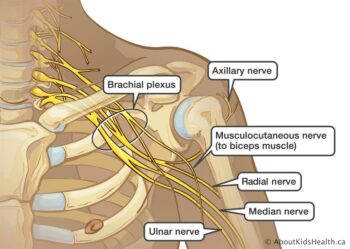How often do you wake up with your arms feeling dead, heavy or numb and think your arm has fallen asleep? Well, your arm has not fallen asleep, and it’s not the blood supply being shut off either. What is happening is that you compressed or irritated a nerve in your neck which affects the communication of your nervous system from your neck to your arm.
Of course, over a short period of time the feeling comes back. More commonly people complain of tingling or weakness in their arm. It can be the whole arm, or just the fingers.

To understand why your hands tingle, or are weak, you need to know some basic anatomy of your body. It is your body after all, and the more you know about how your body functions the better care you will take of it. That is of course if you want to stay active for the rest of your life and not end up sitting on a bench observing others enjoying life.
The nerves that control your arms come from the neck. There are 7 vertebrae in your neck which are called cervical vertebra and the 7 are named C1 to C7. The neck houses and protects the upper part of your spinal cord. Oh yes, the spinal cord. It is an extension of the brain and lives in the spinal column which is made up of 24 vertebrae. The spinal column protects the spinal cord and is amazingly very mobile having 135 joints. We are focusing on the neck in this blog. The way the spinal cord communicates with the rest of the body’s muscles and organs is through nerve roots which exit out of holes (or foramen) between the vertebrae. In the neck there are 8 nerves roots (C1-8; go figure). Nerves roots from the levels of C5-T1 (T = thoracic spine, or the chest area where the ribs are) make up the brachial (or arm) plexus. The brachial plexus is a cable that can be the size of your pinky as it dives under your collar bone. There it has a tight squeeze between the collar bone and 1st rib before it goes through your armpit. In your armpit the brachial plexus divides into severe nerve bundles. The 3 most prominent ones are named the radial, ulnar and median nerves.
Each of these 3 nerves have specific functions and tingling patterns. Anywhere these nerves travel from your neck to arm can become impinged or entrapped. The nerves tend to live in the spaces between muscle groups.
For example, carpal tunnel syndrome is a compression of the median nerve. The median nerve innervates the first 3 fingers (thumb, index and middle). The median nerve can be crushed anywhere from where it exits the neck to when it goes through the carpal tunnel. The carpal tunnel is just that. It is a tunnel made of 3 sides of bones forming a “U” and a ligament band across the 2 ends. Carpal tunnel surgery entails creating more space in the tunnel to give the nerve more room.
The ulnar down the arm to the 4-5th fingers (ring and pinky). If you feel numbness and tingling in the 4th and 5th fingers you have an issue with your ulnar nerve. The ulnar nerve also is the “funny bone” nerve on the inside of your elbow. In fact, the muscles that cause golfer’s elbow are innervated by the ulnar nerves.
The radial nerve controls the muscles that extend your wrist and fingers. Irritation of the radial nerve can cause tingling on the top of your hand, but not in the fingers. The muscles involved in tennis elbow are innervated by the radial nerve
When the whole hand tingles or feels numb, it usually means the whole brachial plexus is involved and is being compressed anywhere from the neck to the armpit. As I described earlier it is a “tight area” and there is not a lot of room for the nerve even if you have perfect posture. It doesn’t take much compression to affect the nerve. Muscle tightness can make these tight spaces become even smaller by entrapping the nerve causing compression. Inflammation caused by injury also makes the space smaller. Inflammation can be caused by trauma, or an injury. More often I find it is from repetitive poor motion. The biggest initiator of irritation to the brachial plexus is poor posture.
Look around you, or just in the mirror. Most of us have less than optimum posture. That is mostly due to our lifestyle. We are slouched forward when we type, when we drive, when we use our smart phones. When you slouch you close the space where the brachial plexus resides. I have found after 40 years of chiropractic practice that almost all my patients who complain of carpal tunnel, golf or tennis elbow, and shoulder symptoms also have a neck issue also, whether the neck is symptomatic or not.
What happens when you slouch? Try it. Stand up. Put your arm to your side with your thumb pointing out (away from your body). Now Slouch and try to raise your arm sideways as high as you can. Notice where the arm stops. Now do the same thing, but this time stand up as straight (or as military) as you can. What is the difference? Your arm went up much higher with good posture, didn’t it?
What do I find during exams of patients with arm symptoms? The posture is almost always head forward of the gravity line and the shoulders are rolled forward. When I measure neck range of motion there is always decreased extension and usually decreased rotation and lateral bending on the side of the arm symptoms. There is also dysfunction or and fixation of the motion of the neck vertebrae corresponding to the nerve that is involved.
For that reason, both the neck and arm complaints need to be addressed for successful relief and correction of the arm symptoms affecting your quality of life. On a daily basis I meet people who have suffered from tennis elbow for years. They have seen multiple providers with minimal or no benefit. After my examination I can usually demonstrate the nerve connection from the neck to their arm symptoms. Treatment includes both arm and neck dysfunction and before you know it they are back on the tennis court (or golf course). No prior provider had looked at the whole chain from then neck or tested for entrapment of the nerves involved.
Now you know more than most when it comes to the neurology of the hand. If your hand is tingling, numb or weak, what can you do? You can probably now diagnose which nerve is involved. Here’s a quick summary. If it is your first three fingers, think median nerve. If it is your 4th to 5th fingers, or inside of your elbow, think ulnar nerve. If it is the outside of your elbow or the back of your forearm, think radial nerve. If it is your whole hand it is your brachial plexus. Look in the mirror? How is your posture? Here is another test. Put up both your hands in the stick-up position. Shoulder and elbows at 90 degrees. Your fingers pointing to the ceiling. Hold this position for at least 30 seconds. If your fingers start to tingle then the impingement is 100% somewhere from the neck to the armpit.
Posture can’t be improved without assistance. Maybe you can get a few more centimeters of height and a few degrees less of your upper back curve with self-care. But just as you can’t straighten your teeth without braces, you need help improving your posture. Chances are that your chest and front of the neck muscles are short and tight, and your upper back muscles are long and weak, and the vertebrae in your neck and upper back are stuck holding your upper back and neck forward. A skilled chiropractor knows how improve the motion to the vertebrae, release the nerve impingements and remove adhesions in tight muscles which restores function.
Then it becomes your responsibility to improve your ergonomics when you use your computer and phone. There are specific stretches and tips to improve your posture. Please see the links below for self-care strategies:
If you have arm symptoms, remember it all starts in the neck! For more information on self-care tips, and when you need to see an expert, please email me @ [email protected]
